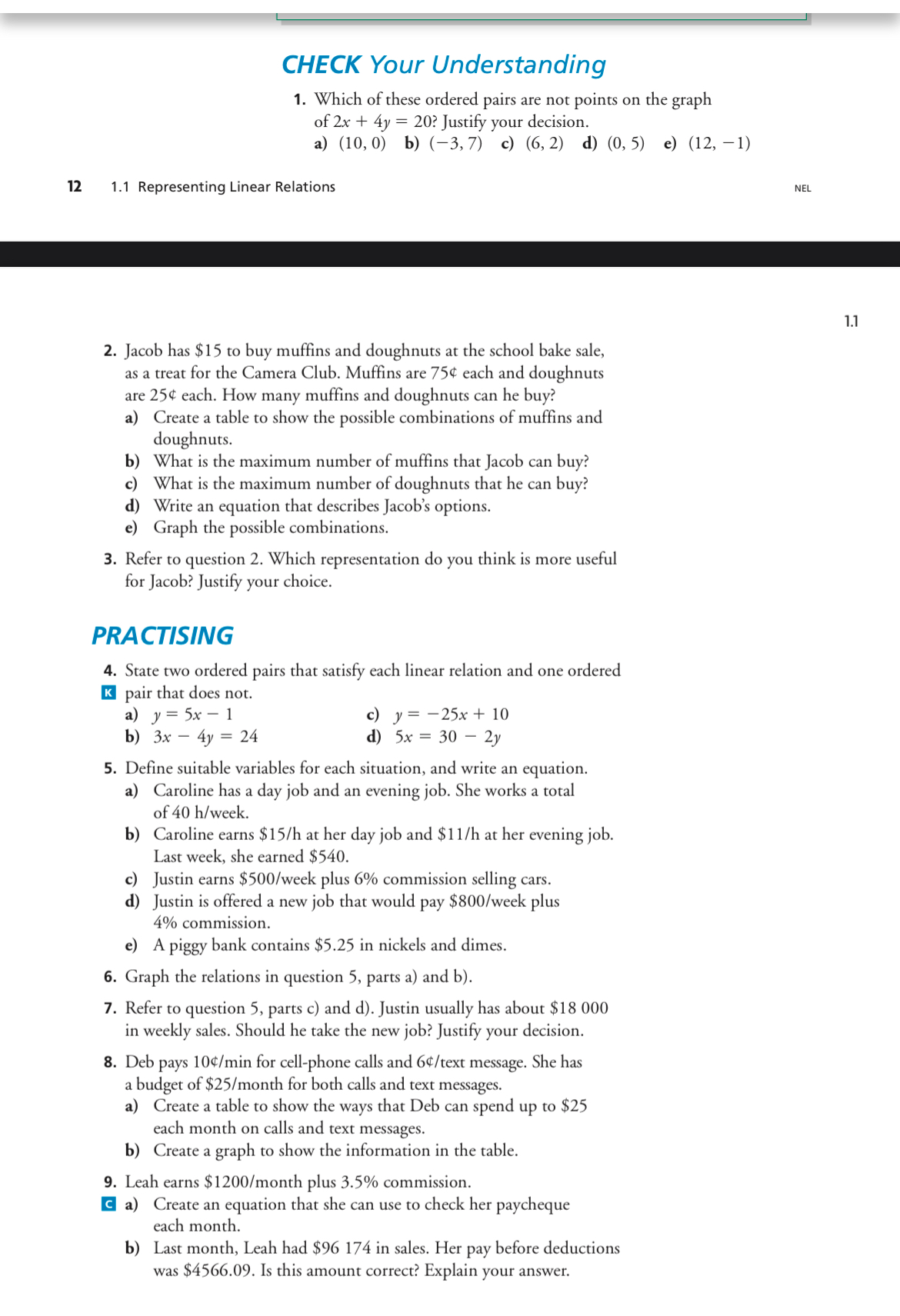1. Which of these ordered pairs are not points on the graph of 2x + 4y = 20? Justify your decision. 2. Jacob has $15 to buy muffins and doughnuts. Muffins are 75¢ each and doughnut... 1. Which of these ordered pairs are not points on the graph of 2x + 4y = 20? Justify your decision. 2. Jacob has $15 to buy muffins and doughnuts. Muffins are 75¢ each and doughnuts are 25¢ each. How many muffins and doughnuts can he buy? a) Create a table to show possible combinations. b) What is the maximum number of muffins? c) What is the maximum number of doughnuts? d) Write an equation describing his options. e) Graph the combinations. 3. Refer to question 2. Which representation is more useful for Jacob? Justify your choice. 4. State two ordered pairs that satisfy each linear relation and one ordered pair that does not. a) y = 5x - 1 b) 3x - 4y = 24 c) y = -25x + 10 d) 5x = 30 - 2y. 5. Define suitable variables and write equations for a) Caroline's jobs, b) Justin's earnings. 6. Graph relations from question 5 parts a and b. 7. Leah earns $1200/month plus 3.5% commission. a) Write an equation to check her pay. b) Last month, Leah earned $96,174 in sales. Was her pay correct before deductions?

Understand the Problem
The question involves a series of mathematical problems related to linear equations and practical applications. It asks for various calculations related to buying items, graphing equations, and analyzing financial situations.
Answer
Maximum muffins: $m = 20$, Maximum doughnuts: $d = 60$, Equation: $0.75m + 0.25d = 15$.
Answer for screen readers
Jacob can buy a maximum of 20 muffins or a maximum of 60 doughnuts. The budget equation is $0.75m + 0.25d = 15$.
Steps to Solve
-
Identify variables Let ( m ) be the number of muffins and ( d ) be the number of doughnuts. The cost for muffins is $0.75 each and for doughnuts is $0.25 each.
-
Set up the total cost equation The total money Jacob has is $15. Therefore, the equation for the cost is: $$ 0.75m + 0.25d = 15 $$
-
Create a table of combinations To find combinations of muffins and doughnuts, express ( d ) in terms of ( m ): $$ d = \frac{15 - 0.75m}{0.25} = 60 - 3m $$
-
Calculate combinations Now, generate values for ( m ) and find corresponding ( d ):
- If ( m = 0 ): ( d = 60 )
- If ( m = 1 ): ( d = 57 )
- If ( m = 2 ): ( d = 54 )
- Continue until maximum muffins are found.
-
Determine maximum muffins Jacob can buy To find the maximum number of muffins, set ( d = 0 ): $$ 0.75m = 15 \implies m = 20 $$
-
Determine maximum doughnuts Jacob can buy Set ( m = 0 ): $$ 0.25d = 15 \implies d = 60 $$
-
State the equation for Jacob's options The equation we already derived is: $$ 0.75m + 0.25d = 15 $$
-
Graph the combinations Plot the combinations of ( m ) and ( d ) from the generated table to visualize possible combinations within the budget.
Jacob can buy a maximum of 20 muffins or a maximum of 60 doughnuts. The budget equation is $0.75m + 0.25d = 15$.
More Information
Jacob’s options reflect the relationships between the quantities of muffins and doughnuts he can buy. The equation is linear, which allows for a straightforward graphical representation and analysis of choices, highlighting the trade-off between the two items within his budget constraints.
Tips
- Not using the correct pricing: Make sure to correctly apply the cost of each item in calculations.
- Not setting limits on quantities: Remember that ( m ) and ( d ) cannot be negative or exceed the budget.
- Misinterpreting the slope in the graph: Ensure that when graphing, the axes are correctly labeled, representing muffins and doughnuts accurately.